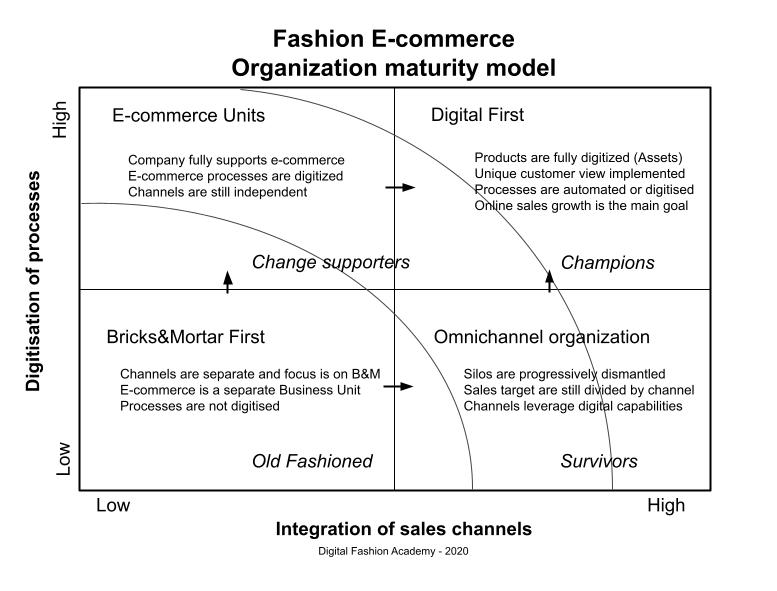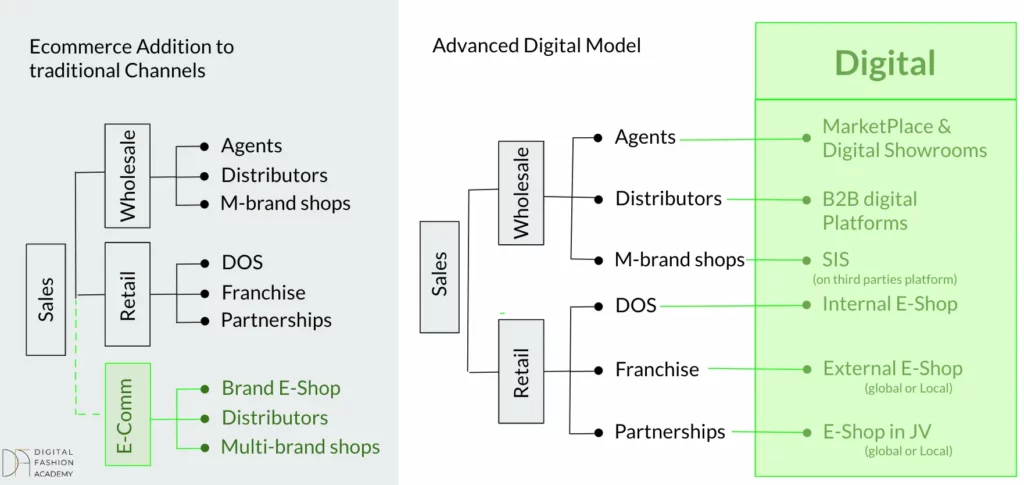Digital transformation has been on the agenda of Fashion companies for a few years now, however even the large players with immense financial resources are struggling with this transformation process.
The biggest issues for fashion companies when dealing with digital transformation:
- The top management is not trained on Digital Management
- Decisions are not yet sufficiently based on data.
- Need for investment in technology
- Need to structure the Organization and processes
What are the benefits and risks from digital transformation?
Benefits:
- More efficiency: this means saving money and increasing margins both from sourcing products and also from operating expenses, therefore increasing the EBITDA
- Improved quality of decisions: decisions will be based on accurate data and more up-to-date or real time data
- Streamlined processes: with digital transformation processes need to be clearly defined step-by-step.
Risks
- Need for re-training Senior Management: workers with an old-fashioned mentality may not be able to adapt easily
- Need for change: the implementation of a transformation process will require change working habits
- Employees resistance: people who have worked with the same methodology for several years may oppose the change and jeopardize the digital transformation process
How to deal with the risks of digital transformation?
In order to favour the adoption of digital best practices it’s necessary to adopt an incremental approach, with the goal of moving the organisation through a maturity growth in digital capabilities. The company growth can be achieved by providing training and coaching to the people involved in the transformation.

What are the enablers for the digital transformation in fashion companies?
The are some conditions that are necessary to start a digital transformation process, such as
- availability of digital skilled personnel,
- a management team motivated to change the organization
- budget for investment in IT solution, especially cloud and AI
How to implement digital transformation in fashion industry:
In order to successfully implement Digital Transformation in fashion brands and retailers, Fashion companies should focus on some specific transformative goals:
- Be customer centric: fashion brands should build the experience around the customer journey and focus on how to implement the customer satisfaction, read more about this in this article “unlocking customer satisfaction“.
- Near real time decision making: fashion brand should use analytics and business intelligence to make effective decisions rapidly;
- Management by objectives and non by process: every process should have a KPI to measure the results;
- Learn how to learn: companies should incentivate the ability to learn of their employees, for example making a catalog of relevant courses accessible to employees and rewarding the effort of employees to keep developing professionally and training.
Some apparel, fashion, and luxury companies won’t survive the current crisis; others will emerge better positioned for the future. Much will depend on their digital and analytics capabilities. […] Although no one in the industry foresaw the intensity of this crisis, some fashion companies are finding that they are better equipped than others—largely because of their digital know-how.
McKinsey – Fashion digital transformation
How to implement effective training programs for employees in the fashion industry
At Digital Fashion Academy we have worked hard to create the most advanced training program in Fashion Business Management adopting the most flexible solutions for our students. But we didn’t stop there, we also adopted the digital solutions for training that allow our students to interact with each other like they were physically present in the room and more.
Our approach requrires students to work together to build strategies and plans, priorities projects and analyse performance of fashion brands.

During the lessons the students are also challenged to examin real life situations and discuss them to understand how things work in the complex world of fashion.

Acceleration and Deceleration of Digital Transformation
The pandemic crisis has accelerated a process of digital transformation that would have taken years to accomplish. However only some activities in the organisation of fashion companies can be actually digitally transformed in a matter of weeks. For example employees well accepted the change in their working habits moving from the offices to their homes, and companies and governments were happy and proactive to support this change by facilitating for example all the situations in which parents-workers were working from home and caring for their children at the same time. The supply chain instead was not ready to be digitally transformed and the production of samples and delivery of the collection was affected negatively by the pandemic crisis.
What really changed in a matter of days at the beginning of the pandemic crisis was the customer behaviour. Customer quickly moved from Bricks and Mortar stores to e-commerce websites. Whenever they had the need to purchase something during the pandemic they were able to get it online and delivered at their homes. Of course the needs were also different and therefore some product categories were penalised and some saw a surge of demand, for example home-wear and loungewear increased while luxury and travel accessories decreased.
The next steps in fashion digital transformation
The challenges ahead of us are unclear, but we can learn a few lessons from this crisis:
- Digital transformation needs to be happening in all activities of the value chain from product design to retailing
- Digital transformation needs to be governed by CEOs together with Cross-Functional team leaders
- The technological infrastructure of a company is a competitive asset and can determine competitive advantage
- Organisational models in headquarters and retail need to be flexible and malleable
- Analytical skills, Digital skills and People skills are essential to the success of the fashion companies
The digital transformation assessment of your company
If you are interested in the digital transformation process of your company, you can take the digital transformation self assessment for free here: digital transformation test.
Before the pandemic crisis, fashion companies were able to carry on with their business as it had been done for the past 20 years or more. The supply chain was working well and integrated at global level, the distribution was developing with new form of traditional retailing experience and employees of fashion brands were working more or less effectively and happily in fashion companies.
Then, all of a sudden the pandemic crisis has disrupted the majority of fashion retailing processes in a matter of weeks: supply chains from China stopped working, departments stores and shopping centres closed their doors and employees have been forced to work from home.
It’s not possible to give a yes or no answer to this question, but we see that the companies who are investing in digital resources hiring digital savvy people and implementing digital projects can achieve their goals more effectively than the companies that aren’t investing in digital solutions.

